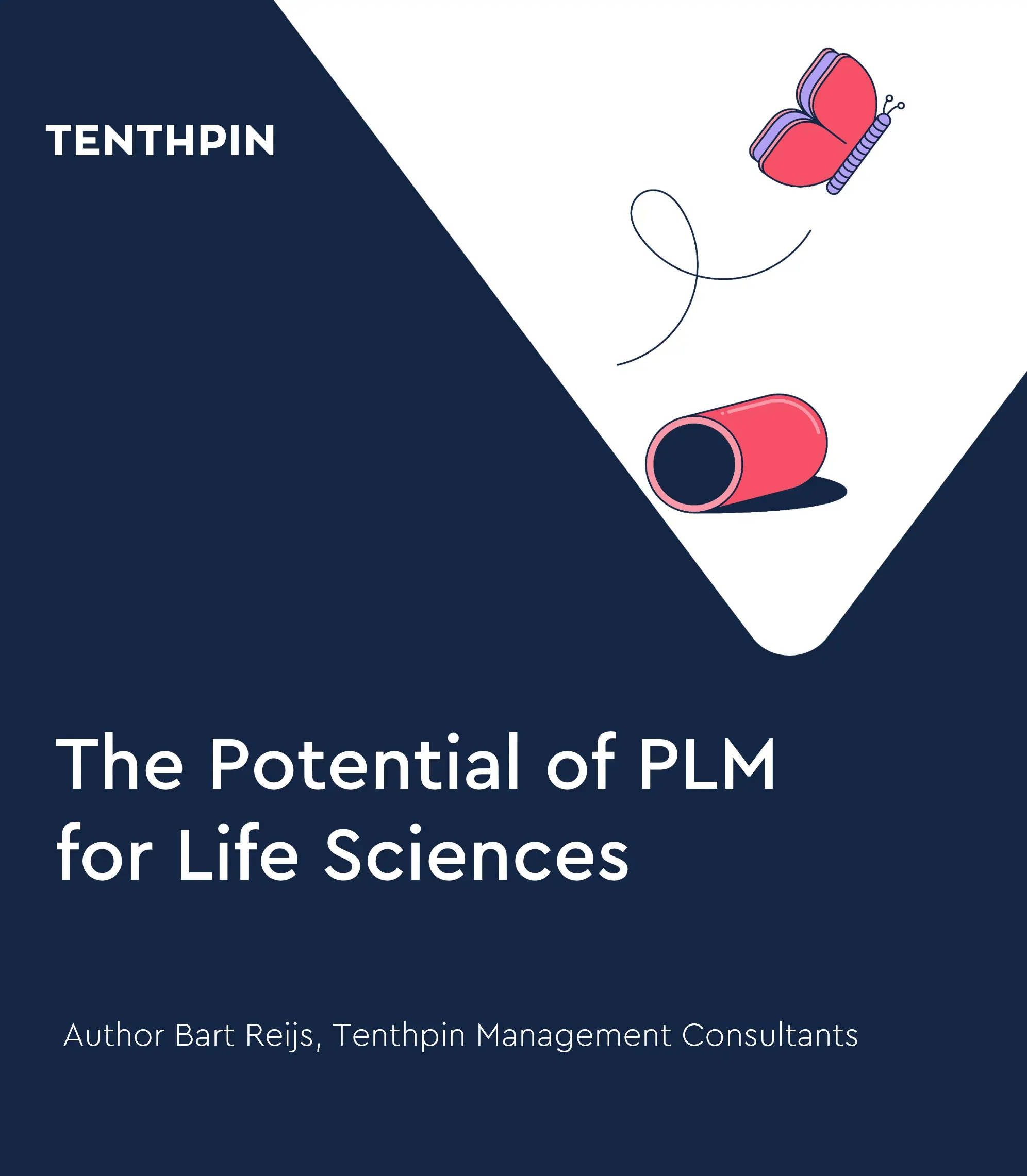How Life Sciences Companies Can Maximize the Potential of PLM Solutions

Table of content
Purpose-built Product Lifecycle Management (PLM) solutions accelerate innovation while ensuring regulatory compliance and addressing the complexities of drug development. As technology capabilities continue advancing at a rapid pace, the opportunity to meaningfully transform legacy practices is more relevant than ever before. In this article, Bart Reijs explores the challenges, benefits, and success factors of PLM.
The Potential of PLM for Life Sciences
Developing a new medication is an immensely complex undertaking that requires meticulously building, tracking and maintaining a vast array of interconnected product data across global teams spanning numerous disciplines. From the earliest drug discovery stages through clinical trials, regulatory approvals and ultimate commercialization, comprehensive data on chemical compounds, formulations, manufacturing processes, analytical test methods, specifications and more must be continuously generated, evaluated and updated.
This intricate web of interdependent product records forms the critical backbone for all development activities and decision-making. Later it forms the foundation for scale up, use guidance and global supply. Any disruptions to establishing and sharing this data in a controlled, traceable manner introduces significant risks of delays, costly reworks, quality issues and compliance failures that can derail entire multi-year, multi-billion dollar programs. Or the access to patients once on market.
In the current operating model prevalent across most pharmaceutical companies, product data tends to become fragmented and inconsistent due to:
- Functional Silos - Different product perspectives generated by research, manufacturing, quality, regulatory and commercial groups get trapped in organizational data silos with limited cross-functional visibility and access.
- Manual Processes - Lack of structured systems forces teams to rely on uncontrolled methods like emails, spreadsheets and documents to share product data, leading to version control issues and data integrity problems.
- Disconnected IT Landscape - With no centralized product data backbone, critical data becomes distributed across disparate applications for chemical data, document management, quality testing, manufacturing and more with no or very limited automated integrations.
This dysfunctional state creates an environment where teams waste immense time and resources simply locating, reconciling and verifying the latest approved product data from various sources before they can make informed decisions. Regulatory scrutiny further amplifies these headaches due to lack of end-to-end data traceability and audit trails to substantiate change histories.
As development programs progress, the cumulative impacts of suboptimal data management methodologies cascades. At the multi-year clinical trial stage, lacking a streamlined unified source of product data heightens risks around protocol inconsistencies, drug supply shortages and patient safety issues. Even after approval, maintaining outdated and fragmented product data obstructs routine activities like post-approval changes, regulatory commitments, post-market surveillance and more. Change and use controls are underestimated in efforts and risks. If anything, they are becoming more so with advanced therapy medicinal products and increasing regulatory and jurisdictional requirements.
From Fragmented to Orchestrated 
Keeping pace with these evolving jurisdiction-based mandates substantially increases organizational compliance burdens. Centralizing product data with robust change control and local language capabilities becomes critical to operating efficiently on a global scale.
As development programs progress, the cumulative impacts of suboptimal data management methodologies cascades. At the multi-year clinical trial stage, lacking a reliable unified source of product data heightens risks around protocol inconsistencies, drug supply shortages and patient safety issues. Even after approval, maintaining outdated and fragmented product data obstructs routine activities like post-approval changes, regulatory commitments, post-market surveillance and more.
The Case for PLM in Pharma Product Development
Bringing a new drug to market requires collaboration between many dispersed teams with different areas of expertise spanning basic research, formulation chemistry, preclinical and clinical testing, regulatory approvals, manufacturing, quality control, distribution, post-market surveillance, and eventual retirement.
Without end-to-end visibility into all product data, documents, specifications, and test results, inconsistencies can easily emerge leading to errors, delays, cost overruns, and compliance risks. Companies have resorted to makeshift solutions by bolting together disjointed tools like ERP, document management, forecasting, and bespoke applications into a complex IT hairball.
Some key limitations organizations face today:
- Information Silos & Lack of Cross-Team Transparency: Disjointed systems restrict accessibility to product data locked in functional silos, severely limiting transparency across development, manufacturing, quality, regulatory, and commercialization teams.
- Suboptimal Change Management: Managing changes to product specifications, methods, test data, etc. becomes exponentially complex using manual tools like spreadsheets. It leads to outdated or conflicting product records and confusion around which document / formula / method versions are current vs obsolete.
- Compliance & Audit Risks: Without end-to-end traceability and immutable audit trails tracking all changes, it becomes almost impossible to satisfy regulatory requirements during agency audits and inspections. Data integrity also becomes suspect.
- Quality & Efficiency Issues: Inferior information sharing hampers quality management. Lack of real-time interdepartmental alignment on issues can lead to delays, redundant work, costly errors, deviations, and reworks.
The Product Lifecycle Management (PLM) concept and supporting PLM platforms are designed to directly address these challenges with enterprise-grade, purpose-built capabilities including:
- Centralized “single source of truth” for all product data, documents, specifications, formulas, test results, reports etc.
- Advanced bill of materials, change, version and workflow management across global teams
- Real-time system-wide visibility into latest approved information
- Automated SOPs for new product introduction, change orders, improvements, deviations
- Robust integration with ancillary apps like ERP, MES, QMS for easier reporting
Advantages of an integrated product lifecycle 
By leveraging these strengths of PLM, pharma and biotech companies can transform outdated silo-based information management into a modern hub-based architecture that breaks down cross-functional barriers. This massively amplifies quality, efficiency, and innovation across today’s intricate drug development environments.
Key Capabilities of PLM Platforms for Life Sciences companies
Modern PLM systems equip pharma enterprises with an industrial-grade set of capabilities tailored to the rigorous needs of regulated product development including:
- Centralized Information Repository: PLM provides a single source of truth for all product data – from chemical structures, molecular models, formulations, specifications, documents, test results, manufacturing processes, change orders, task checklists, correspondence, submissions etc. Global teams get access to the same up-to-date information.
- Configurable Workflows: Highly flexible workflow engine allows modelling of business processes for new product introduction, change requests, deviations, corrective actions etc. Automates routing of tasks & documents to different departments.
- Robust Version Control: Every minor tweak to formulas, documents or test methods becomes a new version that is immutable. Superseded versions are retained but clearly marked obsolete so no confusion about what is current.
- Automated Change Management: Any requested changes such as specification updates, process tweaks, new test requirements etc. can trigger automated workflows that route change requests to appropriate teams for impact assessment, approvals, implementation coordination. Prevents unauthorized changes. Provides full audit trail tracking details like timing, approver name, notes for each change order, helping satisfy regulators.
- Advanced Bill of Materials (BOM) Management: Links formulas, documents, manufacturing/test instructions, equipment as different components into a virtual BOM that provides an integrated view of the approved product configuration during each phase. BOM changes automatically trigger change order workflows.
- Regulatory Information Management: Submission publishing, agency correspondence linking & tracking, commitment management etc. to simplify regulatory communication and post-market pharmacovigilance processes. The expanding jurisdictional controls are gradually added to ensure compliant global access.
- Quality Management Integration: Integrates with existing quality management systems to provide direct access to product data like specifications, documents, test results, deviations, Corrective and Preventive Actions (CAPAs) etc. from within the QMS interface. Eliminates data reconciliation needs.
- Manufacturing Integration: Bi-directional data exchange with production control systems allows prompt communication of product/ inventory build status, process deviations, test outcomes etc. to ensure alignment between quality, manufacturing and engineering teams.
- Analytics & Reporting: Advanced analytics around timelines, document status, quality metrics fostered by digital accessibility to unified product data from global operations. Standard reports as well as custom reporting & analytics.
These end-to-end capabilities make PLM the hub of all product data management activities, seamlessly connecting different functional perspectives into an integrated whole. The multiplier effects this backbone provides for quality, efficiency and speed over manual platforms is overwhelmingly positive. The advantages become even clearer when parts of the process are outsourced to external providers like a CDMO. Here controlling product data, versions is even more challenging, inefficient and error prone. Leveraging a PLM can structure transfer for technology, changes to a product or global usage regulations.
Realizing Maximum Value from PLM Investments
Implementing enterprise-grade PLM technology represents a multi-million dollar commitment for pharmaceutical firms. Beyond software licensing, significant services spend goes towards solution design, customization, integrations, data migration, change management and training.
Justifying this investment requires moving from theoretical possibilities to extracting full tangible value across real performance metrics. Organizations can amplify PLM success by focusing on 3 key imperatives:
- Managing User Adoption
- Business Process Reengineering
- Committing Leadership Mandates
The collective impact stemming from people, processes and leadership communication outlines the real recipe for long-term PLM value. Sustaining this framework with continuous improvement embedded across the organizational culture can help amplify ROI.
Integrated PLM Framework 
Conclusion:
In closing, the integrated capabilities offered by digital platforms like SAP PLM usher an unprecedented opportunity for biopharma companies to overhaul outdated silo-based work modes. Implementing product lifecycle management purpose-built for regulated industry needs can unlock immense efficiencies. It can prove to be the most efficient and reliable manner to manage the rapidly increasing complexity due to advanced therapies, personalized treatments and increasing local regulations.
Centralizing global collaboration, maximizing real-time transparency while retaining precise change control and compliance provides the backbone needed for innovation excellence. As technology capabilities continue advancing at a rapid pace, the window to meaningfully transform legacy practices is now. Pharma and biotech companies that proactively lead this wave stand to gain sustainable competitive advantages for decades ahead.
The Potential of Product Lifecycle Management (PLM) for Life Sciences

Want to know more about challenges, benefits, and success factors of Product Lifecycle Management solutions for Life Sciences companies? Read Tenthpin's Whitepaper to discover the key capabilities that PLM systems for pharma companies should have, and learn how they can maximize the value of their PLM investments.
INSIGHTS
Related insights
Tenthpin is one of the leading consulting partners in the Life Sciences industry, specializing in clinical trials. In this...
SAP is the digital core in most Life Sciences companies worldwide. As the industry moves towards becoming more data-driven, the...
Many Life Sciences companies recognize the need to innovate, but struggle with where and how to begin. That’s not a surprise....







